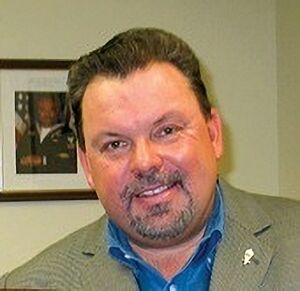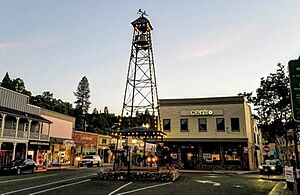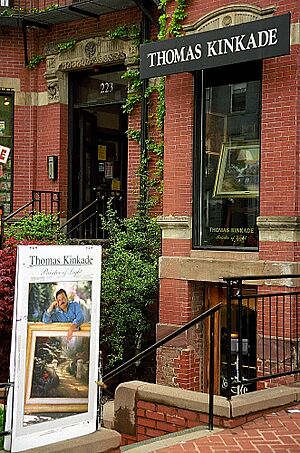Thomas Kinkade facts for kids
Quick facts for kids
Thomas Kinkade
|
|
|---|---|

Kinkade in 2005
|
|
| Born |
William Thomas Kinkade III
January 19, 1958 Sacramento, California, U.S.
|
| Died | April 6, 2012 (aged 54) Monte Sereno, California, U.S.
|
| Education | ArtCenter College of Design, Pasadena |
| Known for | Painting |
| Spouse(s) |
Nanette Willey
(m. 1982) |
William Thomas Kinkade III (January 19, 1958 – April 6, 2012) was a famous American painter. He was known for his realistic and peaceful paintings. His art often showed beautiful country scenes and cozy cottages.
Kinkade became very successful during his life. His company, the Thomas Kinkade Company, sold many printed copies of his paintings. They also sold other products with his art on them. His company said that one out of every 20 homes in America owned a copy of his work.
Kinkade called himself the "Painter of Light." This phrase was a special trademark for him. He died when he was 54 years old.
Contents
Early Life
William Thomas Kinkade was born on January 19, 1958. This was in Sacramento County, California. He grew up in a town called Placerville.
He finished high school in 1976. Then, he went to the University of California, Berkeley. He also studied at the Art Center College of Design in Pasadena. Some artists, like Glenn Wessels, helped teach Kinkade before college.
Career
In June 1980, Kinkade traveled across the United States. He went with his college friend, James Gurney. They ended their trip in New York. There, they got a contract to create a sketching handbook. Two years later, they published a book called The Artist's Guide to Sketching. It became a very popular book.
Because of the book's success, they worked for Ralph Bakshi Studios. They created background art for an animated movie. The movie was called Fire and Ice, released in 1983. While working on the movie, Kinkade started to explore how to show light in his art. He also began to paint imaginary worlds.
After the movie, Kinkade became a full-time painter. He sold his original artworks in galleries across California.
Artistic Style and Themes
Kinkade's paintings have some special features. They often use soft, pastel colors. They also show scenes filled with bright light. His art often shows peaceful and perfect settings. These include gardens, streams, stone cottages, lighthouses, and small town streets.
His hometown of Placerville inspired many of his street and snow scenes. He also painted many Christian themes. These included the Christian cross and churches. His country scenes rarely showed people. Many people asked him about this.
Kinkade said he wanted to show the value of simple joys. He also wanted to share inspiring messages through his art. He was a "devout Christian." He believed his faith gave him ideas for his paintings. He wanted his work to have a moral meaning. Many of his pictures included references to Bible passages.
In 2009, he painted a picture of the Indianapolis Motor Speedway. This was for the cover of the 2009 Indianapolis 500 race program. He included details of the crowd. He even hid figures of famous people like Norman Rockwell in it. He also painted a farewell picture for Yankee Stadium.
Kinkade explained his passion for capturing memories. He wanted to show the feeling people have about an experience. He said he imagined the track and stadium. He then tried to put that excitement into his painting. He added flags to create a patriotic feeling.

Some art critics had different views on Kinkade's style. Essayist Joan Didion said his paintings used slightly unreal pastel colors. She felt his cottages were so cozy they seemed almost scary. She said every window was lit, making the inside look like it was on fire.
Didion compared Kinkade's bright "glow" to the style of 19th-century painter Albert Bierstadt. She worried that Kinkade's paintings of nature ignored sad historical events. For example, his painting of the Sierra Nevada mountains included an imaginary Native American camp. She felt this ignored the forced removal of the Sierra Miwok Indians during the Gold Rush.
Mike McGee, an art center director, wrote about Kinkade's art. He said Kinkade's paintings were technically good. But he thought Kinkade's real talent was knowing what his audience wanted. He also praised Kinkade's smart marketing. McGee suggested Kinkade was a "Conceptual artist" because his art was about ideas. He noted that Kinkade truly believed in his faith and his goals as an artist.
How His Art Was Made
Kinkade designed and painted all of his original artworks. Then, his company used a special process to make many prints. These prints were then sold to people. He also had studio helpers. They helped create many copies of his famous oil paintings. So, while Kinkade made the original art, many of the copies people owned were printed. These prints were then touched up by hand by other artists.
Kinkade is one of the most copied artists. This is partly because of new digital printing technology. Many fake hand-painted copies are made in other countries. In 2011, Kinkade's studio said he was the most collected artist in Asia. However, he did not earn money from those regions because of all the fake copies.
Business of Art
Kinkade's artworks were sold in special stores and by mail. Some prints had extra light effects painted on them by hand. These touches made the prints look more like original paintings. They were sold for higher prices.
His images were also used on many other products. These included calendars, jigsaw puzzles, greeting cards, and CDs. This was thanks to deals with companies like Hallmark. By 2009, his images even appeared on Walmart gift cards.
Around the year 2000, there were hundreds of Thomas Kinkade Signature Galleries. These were stores that sold his art. However, many of them struggled during the economic downturn in the late 2000s. In 2010, his company that made the art filed for bankruptcy protection. They planned to lower costs by having other companies make their products.
Special Projects and Partnerships
Many groups chose Kinkade to celebrate important events. He painted for Disneyland's 50th anniversary. He also painted for Walt Disney World Resort's 35th anniversary. He created art for Elvis Presley's Graceland and Yankee Stadium's farewell season. Kinkade also honored Fenway Park with his art.
He was chosen to paint the historic Biltmore House. He also created a special painting for the 50th running of the Daytona 500 race in 2008.
In 2001, a company called Media Arts created a Kinkade-themed neighborhood. It was called "The Village at Hiddenbrooke." It was built near Vallejo, California. One writer visited the community. She found it was different from Kinkade's ideal vision. Instead of charming cottages, there were regular houses. There was no church or cafe to bring the community together.
Charity Work
Kinkade gave money to groups that helped children, people in need, and the arts. These included the Make-a-Wish Foundation and World Vision. He also supported Art for Children Charities and the Salvation Army.
In 2002, he worked with the Salvation Army. He created two charity prints: The Season of Giving and The Light of Freedom. Money from these sales went to help victims of the September 11 attacks and their families. More than $2 million was donated because of this partnership.
In 2003, Kinkade became a national spokesperson for the Make-A-Wish Foundation. In 2004, he went on a "20 Years of Light Tour." During this tour, he raised over $750,000. He also helped grant 12 wishes for children with serious medical conditions.
In 2005, the Points of Light Foundation named Kinkade an "Ambassador of Light." This group helps people volunteer to solve social problems. Kinkade was only the second person to be chosen for this role. The first was former U.S. President George H. W. Bush. Kinkade traveled to cities to raise awareness and money for the Foundation.
Archbishop Mitty High School in San Jose opened the "Thomas Kinkade Center for the Arts" in 2003. Kinkade was a member of the Church of the Nazarene.
Awards and Recognition
Kinkade received many awards for his art. He won several "Artist of the Year" and "Graphic Artist of the Year" awards. These were from the National Association of Limited Edition Dealers (NALED). His art was also named "Lithograph of the Year" nine times.
In 2002, Kinkade was added to the California Tourism Hall of Fame. This was for how his art showed California sights. He was chosen with other artists to celebrate the 2002 Salt Lake City Winter Olympics. He also helped celebrate the 2002 World Series. He received the 2002 World Children's Center Humanitarian Award. This was for his work helping children and families.
In 2003, Kinkade became a national spokesperson for the Make-A-Wish Foundation. In 2004, he was chosen again to paint the National Christmas Tree in Washington, D.C. His painting, Symbols of Freedom, was the official image for the 2004 event.
In 2004, NALED gave Kinkade an award. It recognized him as the artist who had won the most awards in 25 years. In 2005, he was named the NALED Graphic Artist of the Year. He also received the Eugene Freedman Humanitarian Award for his charity work.
Personal Life
Kinkade married Nanette Willey in 1982. They had four daughters: Merritt (born 1988), Chandler (born 1991), Winsor (born 1995), and Everett (born 1997). All their daughters were named after famous artists.
Death
Thomas Kinkade died at his home in Monte Sereno, California, on April 6, 2012. He was 54 years old. He is buried at Madronia Cemetery in Saratoga, California.
Images for kids
See also
 In Spanish: Thomas Kinkade para niños
In Spanish: Thomas Kinkade para niños









